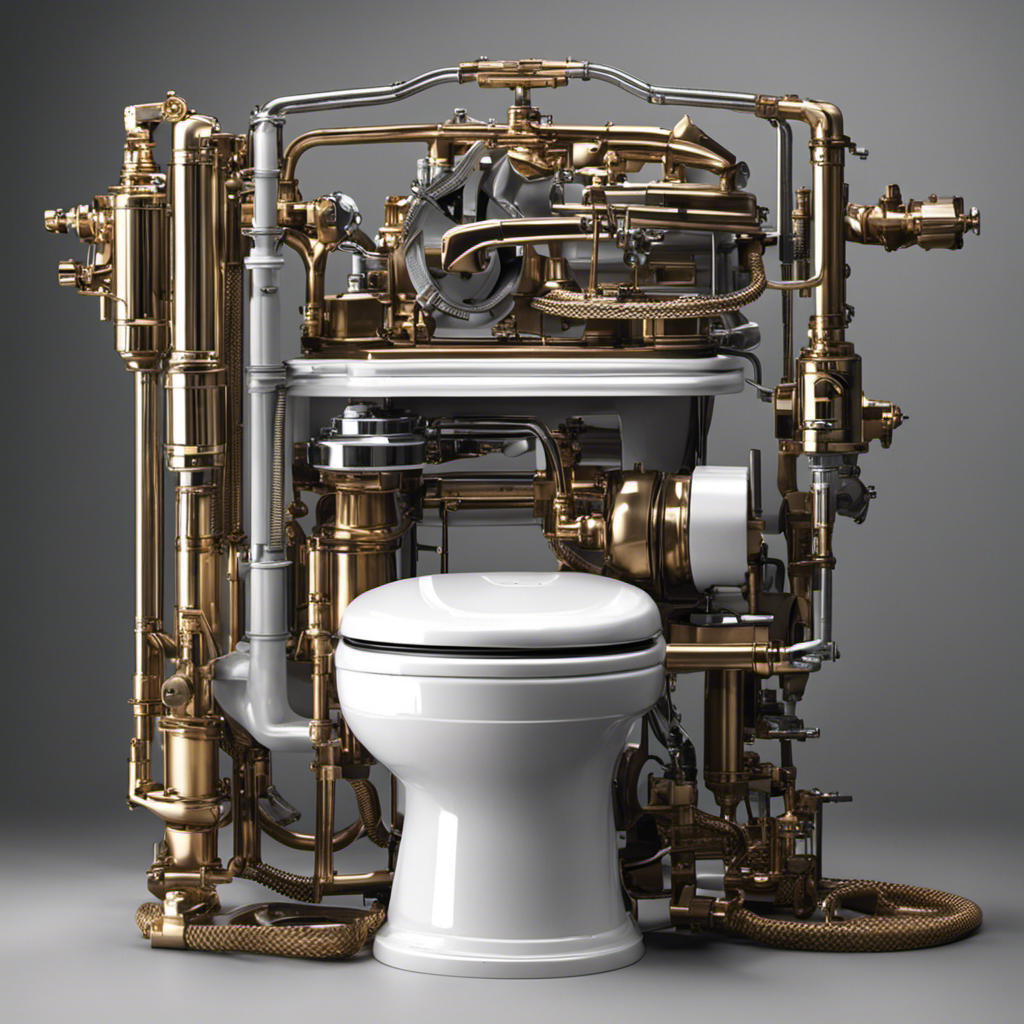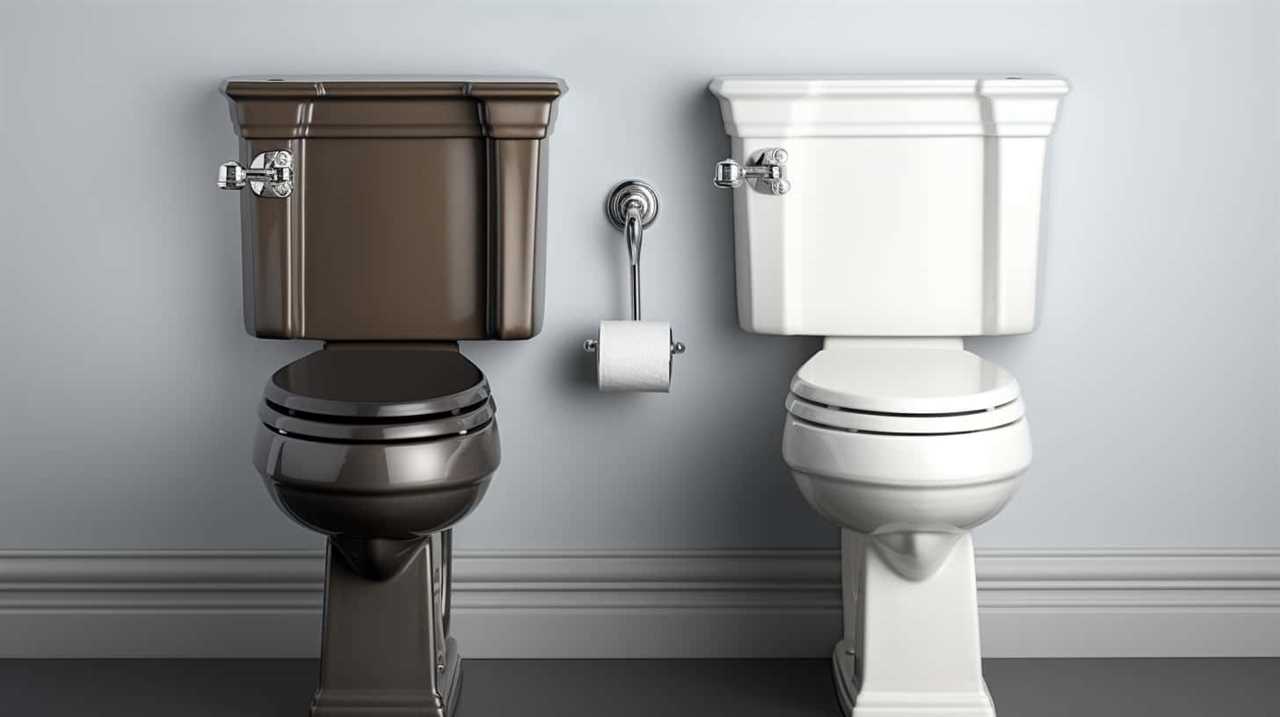Do you find yourself constantly hearing the annoying sound of your toilet running? Well, fear not! I’m here to share with you some practical tips on how to get your toilet to stop running.
In this article, we’ll explore the common causes behind a running toilet and provide step-by-step instructions on how to fix them. From checking and adjusting the float to replacing the flapper valve, we’ll cover it all.
So, let’s dive in and put an end to that never-ending water flow!
Key Takeaways
- Faulty flapper, loose chain, damaged or malfunctioning float, and water pressure issues are common causes of a running toilet.
- Checking and adjusting the float height, inspecting the float mechanism, troubleshooting water level issues, and locating the fill valve are important steps in resolving a running toilet.
- Damaged float mechanisms can be replaced by turning off the water supply, draining the tank, disconnecting and replacing the float mechanism, and reconnecting and turning on the water supply.
- Troubleshooting water level issues involves adjusting the float mechanism, identifying constant running or overflowing water, bending the metal rod or turning the adjustment screw, and testing the water level after each adjustment.
Understanding the Common Causes
The most common reasons for a running toilet are a faulty flapper or a loose chain. When the flapper doesn’t seal properly, water continuously flows into the toilet bowl, causing it to run. To fix this issue, I recommend checking the flapper and replacing it if necessary.
Another potential cause is a loose chain that connects the flush handle to the flapper. If the chain is too long, it can prevent the flapper from closing properly, leading to a running toilet. Adjusting the chain length should solve this problem.
Additionally, it’s important to consider the toilet float. If it’s damaged or not functioning correctly, it can cause water pressure issues and result in a running toilet. To resolve this, perform a toilet float repair or replace the float altogether.
Checking and Adjusting the Float
When it comes to keeping my toilet running smoothly, one of the key points to consider is the float height adjustment. By ensuring that the float is at the correct height, I can prevent issues like constant running or incomplete flushing.
Another aspect to keep in mind is the condition of the float mechanism itself; if it is damaged or malfunctioning, it can lead to water leakage or improper water level control.
In case I encounter any water level troubles, such as low or high water levels, troubleshooting techniques can help me identify and resolve the underlying causes for a more efficient toilet system.
Float Height Adjustment
To fix a running toilet, you should first adjust the float height. The float is a small device that controls the water level in the toilet tank. If the float is set too high, it can cause the toilet to continuously run, wasting water and causing annoyance.
To adjust the float height, locate the fill valve in the toilet tank. There should be a small screw or knob on the fill valve that allows you to adjust the float height. Turn the screw or knob clockwise to lower the float and counterclockwise to raise it.
Test the toilet by flushing it and see if the problem is resolved. If not, there may be other issues causing the running toilet, and further troubleshooting techniques should be employed.
Damaged Float Mechanism
If the float mechanism is damaged, you’ll need to replace it to fix the running toilet. The float mechanism is responsible for controlling the water level in the toilet tank. When it is damaged, it can cause the toilet to continuously run, wasting water and potentially leading to higher water bills.
To troubleshoot and fix this issue, follow these steps:
- Turn off the water supply to the toilet.
- Drain the tank by flushing the toilet and holding down the handle.
- Remove the float mechanism by disconnecting it from the fill valve.
- Replace the damaged float mechanism with a new one.
- Reconnect the float mechanism to the fill valve and turn on the water supply.
Water Level Troubleshooting
One way to troubleshoot the water level in the toilet tank is by adjusting the float mechanism. If you notice that the water in your toilet tank is constantly running or overflowing, it could be due to an issue with the water level.
To adjust the water level, start by locating the float mechanism. It is usually a plastic or metal device that floats on top of the water in the tank. Next, adjust the float mechanism by either bending the metal rod or turning the adjustment screw.
By lowering the float, you can decrease the water level, and by raising the float, you can increase the water level. Make small adjustments and test the water level after each adjustment until it reaches the desired level.
Remember to turn off the water supply before making any adjustments to the float mechanism to avoid any accidents.
These troubleshooting tips should help you resolve any issues with the water level in your toilet tank.
Replacing the Flapper Valve
When it comes to replacing the flapper valve in a toilet, it is important to understand its function, recognize signs of wear, and follow the correct steps for replacement.
The flapper valve serves as a seal between the tank and the bowl, allowing water to flow into the bowl when the toilet is flushed.
Signs of a worn flapper include constant running water, a weak flush, or a toilet that won’t flush at all.
To replace the flapper valve, start by turning off the water supply, removing the old flapper, and installing the new one according to the manufacturer’s instructions.
Flapper Valve Function
To stop your toilet from running, check if the flapper valve is functioning properly. The flapper valve is a crucial component that controls the flow of water from the tank to the bowl. If it is not working correctly, it can cause your toilet to continuously run, wasting water and increasing your utility bill.
To ensure proper flapper valve maintenance, start by checking if it is sealing tightly. Over time, the flapper valve can become worn or damaged, leading to leaks. If you notice any signs of a worn flapper, such as water trickling into the bowl or a constant running sound, it’s time to replace it.
Signs of Worn Flapper
If you notice water trickling into the bowl or hear a constant running sound, it’s time to replace the flapper valve. A worn flapper can cause toilet leaks and lead to flush issues.
Here are some signs that indicate your flapper valve needs to be replaced:
- Water trickling into the bowl even when the toilet is not in use.
- A constant running sound that you can hear but cannot locate the source of.
- The flapper looks worn, cracked, or damaged.
To troubleshoot toilet flush issues, it’s important to check the flapper valve as it is a common culprit. By replacing the flapper valve, you can prevent water wastage and keep your toilet functioning properly.
Remember to turn off the water supply before replacing the flapper valve to avoid any accidents.
Steps to Replace?
Before replacing the flapper valve, make sure to turn off the water supply to avoid any accidents. Here are the steps to repair a worn flapper valve and troubleshooting tips to ensure a successful fix:
-
Turn off the water supply: Locate the shut-off valve near the base of the toilet and turn it clockwise to stop the water flow.
-
Empty the tank: Flush the toilet to drain the water from the tank.
-
Remove the old flapper: Disconnect the chain attached to the flush handle and slide the flapper off the overflow tube.
-
Install the new flapper: Attach the new flapper to the overflow tube, ensuring a tight seal. Reconnect the chain to the flush handle.
| Steps to Replace Flapper Valve | |||
|---|---|---|---|
| 1. Turn off water supply | 2. Empty the tank | 3. Remove old flapper | 4. Install new flapper |
Fixing the Fill Valve
The first step in fixing the fill valve is checking for any leaks. Leaks can cause the toilet to constantly run, wasting water and increasing your water bill. To fix leaks, follow these steps:
- Turn off the water supply to the toilet.
- Flush the toilet to drain out any remaining water.
- Inspect the fill valve for any cracks or damage.
- Replace any faulty parts, such as the flapper or the float valve.
- Connect the new parts securely.
Turn on the water supply and let the tank fill up.
- Adjust the water pressure if necessary.
- Test the toilet by flushing it and checking for any leaks.
Addressing the Water Supply Line
To address the water supply line, you should first turn off the water supply to the toilet. This step is crucial to ensure your safety and prevent any water leakage.
Once the water supply is turned off, you can begin troubleshooting leaks and adjusting the water pressure.
To troubleshoot leaks, start by inspecting the water supply line for any visible damage or loose connections. Tighten any loose fittings or replace damaged parts if necessary. If the leak persists, you may need to replace the entire water supply line.
Adjusting the water pressure can also help resolve issues with a running toilet. Locate the water pressure regulator, usually found near the main water supply valve. Using a screwdriver, turn the adjustment screw clockwise to increase pressure or counterclockwise to decrease pressure. Make small adjustments and test the toilet to ensure the running has stopped.
Remember to turn the water supply back on after completing these steps.
Seeking Professional Help if Needed
If you’re unable to resolve the issue on your own, it’s recommended that you seek professional help for assistance with your running toilet. Sometimes, DIY solutions just aren’t enough and it’s best to leave it to the experts.
Here are a few reasons why professional assistance may be necessary:
-
Complexity of the problem: A running toilet can be caused by various issues, such as a faulty flapper valve, a malfunctioning fill valve, or a damaged flush handle. Identifying the exact problem and finding the right solution can be challenging without proper knowledge and experience.
-
Time and convenience: Hiring a professional plumber can save you time and effort. They have the necessary tools and expertise to quickly diagnose and fix the issue, allowing you to get back to your daily routine without further inconvenience.
-
Peace of mind: Knowing that a trained professional is handling the problem can provide you with peace of mind. They can ensure that the repair is done correctly, preventing any future issues and saving you money in the long run.
Frequently Asked Questions
How Much Does It Cost to Replace a Flapper Valve in a Toilet?
To replace a flapper valve in a toilet, it can cost around $5 to $20. However, there are alternatives such as DIY flapper valve repair that can be more cost-effective.
Can I Use Any Type of Flapper Valve as a Replacement?
Sure, any flapper valve should work perfectly fine as a replacement. Just make sure it’s compatible with your toilet model. Toilet flapper troubleshooting can be a pain, but common problems can be easily fixed.
How Often Should I Check and Adjust the Float in My Toilet?
Toilet float maintenance is important to prevent a running toilet. Regularly checking and adjusting the float ensures proper water level control. Signs of a faulty float include constant running or water overflowing.
Can I Fix a Running Toilet Without Replacing the Fill Valve?
Yes, you can fix a running toilet without replacing the fill valve. First, check the flapper for any leaks or damage. If it’s fine, adjust the float to make sure it’s not too high. This should solve the problem.
How Do I Determine if the Water Supply Line Is Causing My Toilet to Run?
To determine if the water supply line is causing my toilet to run, I need to inspect it. This is an important step in troubleshooting toilet running, as a faulty or clogged supply line can lead to continuous water flow.
Conclusion
So there you have it, folks! I hope this guide has been helpful in teaching you how to get your toilet to stop running.
By understanding the common causes of a running toilet and taking the necessary steps to fix them, you can save yourself from the frustration and wasted water.
Remember, knowledge is power, and now you have the power to tackle this issue head-on. So go ahead and give it a try – don’t be afraid to get your hands dirty!
As they say, ‘A stitch in time saves nine.’ Happy fixing!










